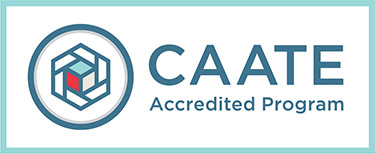Take the Next Step
Finding the right college means finding the right fit. See all that the College of Health, Education, and Human Services has to offer by visiting campus.

On this page:
You can choose a rewarding career field helping others stay healthy and safe by earning a Master of Athletic Training from Wright State University. According to the Bureau of Labor Statistics, employment of athletic trainers is expected to grow 23 percent between 2020 and 2030, much faster than the average for all occupations.
You will learn to prevent, diagnose, and treat orthopedic injuries and medical conditions/illnesses. However, you will acquire more knowledge and be part of a unique learning atmosphere at Wright State. You will:

The WSU ATP has Continuing Accreditation from the Commission on Accreditation of Athletic Training Education (CAATE - 2001 K Street, NW, Washington, DC, 20006). The most recent comprehensive accreditation review was in 2016-2017 and the program was awarded 10 years of accreditation. The next comprehensive review will be in 2026-2027. For more information regarding the program's outcomes, see CAATE Program Information and Outcomes.
Wright State athletic training graduates have found gainful and meaningful employment in the following athletic training settings:

You will experience a high level of experiential learning in Wright State’s athletic training program. Be part of immersive clinical experiences with our highly qualified preceptors. You will have the opportunity to gain on-the-job training at the high school level, collegiate level, general medical setting, and a final immersive clinical rotation that will coordinate with your career goals.
The mission of the Wright State University athletic training program is to educate students in the domains of athletic training, preparing them to assume the role of a healthcare professional in a variety of employment settings and to optimize the quality of health care provided to patients of all ages and physical capacities, thereby maximizing their health-related quality of life.
Athletic Training Policies and Procedures Manual
Here is a sample academic plan if you decide to pursue your master’s degree in athletic training at Wright State:
|
YEAR 1 |
YEAR 2 |
|---|---|
|
|
|
|
Summer B Term |
Summer A & B Term |
|
ATR 7000 (3): Orthopedic Anatomy |
ATR 7600 (3): Neuroscience in AT (A) |
|
ATR 7100 (2): Essentials of Athletic Training |
ATR 7700 (3): Clinical Reasoning (B) |
|
ATR 7200: (3): Emergent & Acute Care |
ATR 7550 (2): Clinical Practice III (A & B) |
|
Total Credits (8) |
Total Credits (8) |
|
|
|
|
Fall Term |
Fall Term |
|
ATR 7300 (5): Orthopedic Assessment |
KNH 7530 (3): Biomechanics |
|
ATR 7400 (5) Therapeutic Interventions |
ATR 7810 (3): Foundations of Clinical Ethics |
|
ATR 7150 (2): Clinical Practice I |
ATR 7750 (2): Clinical Practice IV |
|
|
CNL 7000 (3): Counseling Theories & Techniques for Healthcare Professionals |
|
Total Credits (12) |
Total Credits (11) |
|
|
|
|
Spring Term |
Spring Term |
|
KNH 7800 (3): Research Methods |
ATR 7800 (3): Administrative Concepts |
|
ATR 7500 (5): Medical Conditions & Interventions |
ATR 7950 (4): Clinical Practice V |
|
ATR 7350 (2): Clinical Practice II |
|
|
Total Credits (10) |
Total Credits (7) |
Overall Total Credit Hours (56)
*During the last week of summer B term (3rd week in July), students will be assigned to a 4-week preseason clinical experience until fall class resume (4th week in August). The students will be supervised by a preceptor from one of our local healthcare partners. This clinical experience will be tied to ATR 7100 (1st year) and ATR 7550 (2nd year) in terms of credit hours (i.e. student will receive an incomplete at the end of summer B term which will be converted to a grade following completion of the clinical experience).
Early consideration deadline: December 1 (decision by December 15)
Regular application deadline: March 1 (decision by March 15)
Students who meet the minimum requirements will be considered for direct, unconditional, admission to the program for Summer B Term each year.
After initial acceptance, you must complete the following additional requirements:
| Required Courses | WSU Course Equivalent |
|---|---|
| Strength & Conditioning OR Therapeutic Exercise | ATR 3020 or 3030 |
| Personal Health | HED 1230 |
| Kinesiology OR Biomechanics | KNH 2530 |
| Exercise Physiology | KNH 2550 |
| Nutrition | KNH 2620 |
| Anatomy & Physiology course(s) covering all body systems, preferably utilizing cadaver dissection | ANT 2100/2120 or ANT 3100/3120 |
| General Biology I with associated lab, preferably cells & genes | BIO 1120 |
| General Chemistry I with associated lab | CHM 1210 |
| General Physics I with associated lab | PHY 1110 |
| General/Introductory Psychology | PSY 1010 |
| Abnormal Psychology | PSY 3110 |
| Basic Statistics | STT 1600 or 2640 |
| Suggested Additional Courses | WSU Course Equivalent |
|---|---|
| Introduction to Allied Health Care Professions | ATR 2610 |
| Emergency Medical Response/First Responder. Includes EMT, AEMT, paramedic, AHA, ACLS | ATR 2620 |
| Pharmacology | ATR 4820 |
| Medical Terminology | BIO 1010 |
|
General Chemistry II with associated lab |
CHM 1220 |
| Adapted Physical Education or Working with Special Populations | HPR 2120 |
| Motor Development &/OR Motor Learning | HPR 2430 |
| Course-related to Drug & Alcohol Abuse &/or Addiction | RHB 3620 |
If you have questions about the master’s degree program in athletic training at Wright State, please fill out the form below.
Finding the right college means finding the right fit. See all that the College of Health, Education, and Human Services has to offer by visiting campus.